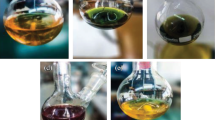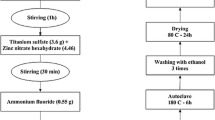Abstract
A novel fast sol–gel method, using polyethylene glycol and polyacrylamide as bi-templates, to prepare the pure, Fe-doped, N-doped, and Fe–N co-doped mesoporous TiO2 samples has been developed. The reaction time is reduced to a few hours for the present work. The IR spectrum has been used to investigate the reaction mechanism of the fast sol–gel method. The results indicate that the fast sol–gel process has been achieved due to the polymerization crosslink between hydrolysates of Ti alkoxides and templates by the intermolecular hydrogen bond. The prepared samples have been characterized by X-ray diffraction, transmission electron microscopy, X-ray photoelectron spectroscopy, N2 adsorption–desorption, and UV–vis spectroscopy. The results show that the samples have a typical ordered mesoporous structure. The crystallite size, pore size, and surface area of Fe–N co-doped TiO2 are about 13.6, 18.4 nm, and 172.08 m2 g−1, respectively. The iron species as the Fe3+ oxidation state are substitutionally doped into the TiO2 lattice, and the doped nitrogen atom is incorporated into the TiO2 lattice as the interstitial N. The co-doping of nitrogen and iron can enhance the absorption of visible region and inhibit the recombination of photogenerated charge carriers, leading to higher photocatalytic activity for the co-doped sample than pure TiO2 and solely doped with iron or nitrogen for degradation of methyl orange under visible light irradiation.








Similar content being viewed by others
References
Ananpattarachai J, Kajitvichyanukul P, Seraphin S (2009) Visible light absorption ability and photocatalytic oxidation activity of various interstitial N-doped TiO2 prepared from different nitrogen dopants. J Hazard Mater 168:253–261. doi:10.1016/j.jhazmat.2009.02.036
Asahi R, Morikawa T, Ohwaki T, Aoki K, Taga Y (2001) Visible-light photocatalysis in nitrogen-doped titanium oxides. Science 293:269–271. doi:10.1126/science.1061051
Bian Z, Zhu J, Wen J, Cao F, Huo Y, Qian X, Cao Y, Shen M, Li H, Lu Y (2011) single-crystal-like titania mesocages. Angew Chem Int Ed 123:1137–1140. doi:10.1002/ange.201004972
Blondeau M, Coradin T (2012) Living materials from sol–gel chemistry: current challenges and perspectives. J Mater Chem 22:22335–22343. doi:10.1039/c2jm33647b
Chen Y, Chang Y, Huang J, Chen I, Kuo C (2012) Light scattering and enhanced photoactivities of electrospun titania nanofibers. J Phys Chem C 116:3857–3865. doi:10.1021/jp2117246
Choi H, Antoniou M, Pelaez M, Delacruz A, Shoemaker J, Dionysiou D (2007) Mesoporous nitrogen-doped TiO2 for the photocatalytic destruction of the cyanobacterial toxin microcystin-LR under visible light irradiation. Environ Sci Technol 41:7530–7535. doi:10.1021/es0709122
Cong Y, Zhang J, Chen F, Anpo M, He D (2007) Photocatalytic activity, and mechanism of nano-TiO2 co-doped with nitrogen and iron. J Phys Chem C 111:10618–10623. doi:10.1021/jp0727493
Docampo P, Guldin S, Steiner U, Snaith H (2013) Charge transport limitations in self-assembled TiO2 photoanodes for dye-sensitized solar cells. J Phys Chem Lett 4:698–703. doi:10.1021/jz400084n
Gao Y, Bai T (2013) Heat capacity for the binary system of quercetin + poly (ethylene glycol) 6000. J Chem Eng Data 58:1122–1132. doi:10.1021/je301114z
Goswami P, Ganguli J (2012) Evaluating the potential of a new titania precursor for the synthesis of mesoporous Fe-doped titania with enhanced photocatalytic activity. Mater Res Bull 47:2077–2084. doi:10.1016/j.materresbull.2012.03.037
Halasi G, Schubert G, Solymosi F (2012) Comparative study on the photocatalytic decomposition of methanol on TiO2 modified by N and promoted by metals. J Catal 294:199–206. doi:10.1016/j.jcat.2012.07.020
Hao H, Zhang J (2009) The study of iron (ш) and nitrogen co-doped mesoporous TiO2 photocatalysts: synthesis, characterization and activity. Microporous Mesoporous Mater 121:52–57. doi:10.1016/j.micromeso.2009.01.002
Hartmann P, Lee D, Smarsly B, Janek J (2010) Mesoporous TiO2: comparison of classical sol–gel and nanoparticle based photoelectrodes for the water splitting reaction. ACS Nano 4:3147–3154. doi:10.1021/nn1004765
Hu S, Wang A, Li X, Lowe H (2010) Hydrothermal synthesis of well-dispersed ultrafine N-doped TiO2 nanoparticles with enhanced photocatalytic activity under visible light. J Phys Chem Solids 71:156–162. doi:10.1016/j.jpcs.2009.10.012
Huang C, Yang Y, Doong R (2012) Microwave-assisted hydrothermal synthesis of mesoporous anatase TiO2 via sol-gel process for dye-sensitized solar cells. Microporous Mesoporous Mater 142:473–480. doi:10.1016/j.micromeso.2010.12.038
Huang T, Mao S, Yu J, Wen Z, Lu G, Chen J (2013) Effects of N and F doping on structure and photocatalytic properties of anatase TiO2 nanoparticles. RSC Adv 3:16657–16664. doi:10.1039/c3ra42600a
Hung I, Wang Y, Huang C, Fan Y, Han Y, Peng H (2010) Effects of templating surfactant concentrations on the mesostructure of ordered mesoporous anatase TiO2 by an evaporation-induced self-assembly method. J Eur Ceram Soc 30:2065–2072. doi:10.1016/j.jeurceramsoc.2010.04.015
Jing D, Zhang Y, Guo L (2005) Study on the synthesis of Ni doped mesoporous TiO2 and its photocatalytic activity for hydrogen evolution in aqueous methanol solution. Chem Phys Lett 415:74–78. doi:10.1016/j.cplett.2005.08.080
Kumaresan L, Prabhu A, Palanichamy M, Murugesan V (2011) Synthesis of mesoporous TiO2 in aqueous alcoholic medium and evaluation of its photocatalytic activity. Mater Chem Phys 126:445–452. doi:10.1016/j.matchemphys.2010.10.036
Lee J, Orilall M, Warren S, Kamperman M, Disalvo F, Wiesner U (2008) Direct access to thermally stable and highly crystalline mesoporous transition-metal oxides with uniform pores. Nat Mater 7:222–228. doi:10.1038/nmat2111
Li Y, Chen J, Liu J, Ma M, Li L (2010) Activated carbon supported TiO2-photocatalysis doped with Fe ions for continuous treatment of dye wastewater in a dynamic reactor. J Environ Sci 22:1290–1296. doi:10.1016/S1001-0742(09)60252-7
Liu X, Gao Y, Cao C, Luo H, Wang W (2010) Highly crystalline spindle-shaped mesoporous anatase titania particles: solution-phase synthesis, characterization, and photocatalytic properties. Langmuir 26:7671–7674. doi:10.1021/la1009384
Liu E, Guo X, Qin L, Shen G, Wang X (2012) Fabrication and photocatalytic activity of highly crystalline nitrogen doped mesoporous TiO2. Chin J Catal 33:1665–1671. doi:10.1016/S1872-2067(11)60437-3
Mangham A, Govind N, Bowden M, Shutthanandan V, Joly A, Menderson M, Chamber S (2011) Photochemical properties, composition, and structure in molecular beam epitaxy grown Fe “doped” and (Fe, N) codoped rutile TiO2 (110). J Phys Chem C 115:15416–15424. doi:10.1021/jp203061n
Rahim S, Ghamsari M, Radiman S (2012) Surface modification of titanium oxide nanocrystals with PEG. Scientia Iranica 9:948–953. doi:10.1016/j.scient.2012.03.009
Rane K, Mhalsiker R, Yin S, Sato T, Cho K, Dunbar E, Biswas P (2006) Visible light-sensitive yellow TiO2-xNx and Fe-N codoped Ti1-yFey O2-xNx anatase photocatalysts. J Solid State Chem 179:3033–3044. doi:10.1016/j.jssc.2006.05.033
Silva C, Juárez R, Marino T, Molinari R, García H (2011) Influence of excitation wavelength (UV or visible light) on the photocatalytic activity of titania containing gold nanoparticles for the generation of hydrogen or oxygen from water. J Am Chem Soc 133:595–602. doi:10.1021/ja1086358
Spadavecchia F, Ardizzone S, Cappelletti G, Oliva C, Cappelli S (2012) Time effects on the stability of the induced defects in TiO2 nanoparticles doped by different nitrogen sources. J Nanopart Res 14:1301. doi:10.1007/s11051-012-1301-y
Su J, Zou X, Zou YC, Li G, Wang P, Chen J (2013) Porous titania with heavily self-doped Ti (3+) for specific sensing of CO at room temperature. Inorg Chem 52:5924–5930. doi:10.1021/ic400109j
Wang X, Hu D, Yang J (2007) Synthesis of PAM/TiO2 composite microspheres with hierarchical surface morphologies. Chem Mater 19:2610–2621. doi:10.1021/cm062561g
Wang Y, Smarsly B, Djerdj I (2010) Niobium doped TiO2 with mesoporosity and its application for lithium insertion. Chem Mater 22:6624–6631. doi:10.1021/cm1020977
Wang J, Zhou Y, Hu Y, Ryan O, Shao Z (2011) Facile synthesis of nanocrystalline TiO2 mesoporous microspheres for lithium-ion batteries. J Phys Chem C 115:2529–2536. doi:10.1021/jp1087509
Wang D, Li X, Chen J, Tao X (2012a) Enhanced visible-light photo electro catalytic degradation of organic contaminants at iodine-doped titanium dioxide film electrode. Ind Eng Chem Res 51:218–224. doi:10.1021/ie202009a
Wang P, Ao Y, Wang C, Hou J, Qian J (2012b) Enhanced photo electro catalytic activity for dye degradation by graphene–titania composite film electrodes. J Hazard Mater 223:79–83. doi:10.1016/j.jhazmat.2012.04.050
Wu Q, Krol RVD (2012) Selective photoreduction of nitric oxide to nitrogen by nanostructured TiO2 photocatalysts: role of oxygen vacancies and iron dopant. J Am Chem Soc 134:9369–9375. doi:10.1021/ja302246b
Wu Y, Xing M, Zhang J (2011) Gel-hydrothermal synthesis of carbon and boron co-doped TiO2 and evaluating its photocatalytic activity. J Hazard Mater 192:368–373. doi:10.1016/j.jhazmat.2011.05.037
Xing M, Wu Y, Zhang J, Chen F (2010) Effect of synergy on the visible light activity of B, N and Fe co-doped TiO2 for the degradation of MO. Nanoscale 2:1233–1239. doi:10.1039/c0nr00078g
Yang M, Hume C, Lee S, Son Y, Lee J (2010) Correlation between photocatalytic efficacy and electronic band structure in hydrothermally grown TiO2 nanoparticles. J Phys Chem C 114:15292–15297. doi:10.1021/jp103764n
Yu J, Wang W, Cheng B, Su B (2009) Enhancement of photocatalytic activity of mesoporous TiO2 powders by hydrothermal surface fluorination treatment. J Phys Chem C 113:6743–6750. doi:10.1021/jp900136q
Yu S, Yun H, Lee D, Yi J (2012) Preparation and characterization of Fe-doped TiO2 nanoparticles as a support for a high performance CO oxidation catalyst. J Mater Chem 22:12629–12635. doi:10.1039/C2JM30360D
Zhang L, Zhu Y, He Y, Li W, Sun H (2003) Preparation and performances of mesoporous TiO2 film photocatalyst supported on stainless steel. Appl Catal B 40:287–292. doi:10.1016/S0926-3373(02)00154-6
Zhang R, Tu B, Zhao D (2010) Synthesis of highly stable and crystalline mesoporous anatase by using a simple surfactant sulfuric acid carbonization method. Chem Eur J 16:9977–9981. doi:10.1002/chem.201001241
Zhou M, Yu J, Cheng B, Yu H (2005) Preparation and photocatalytic activity of Fe-doped mesoporous titanium dioxide nanocrystalline photocatalysts. Mater Chem Phys 93:159–163. doi:10.1016/j.matchemphys.2005.03.007
Zhou C, Zhao X, Yang B, Zhang D, Li Z, Zhou K (2012) Effect of poly (ethylene glycol) on coarsening dynamics of titanium dioxide nanocrystallites in hydrothermal reaction and the application in dye sensitized solar cells. J Colloid Interface Sci 374:9–17. doi:10.1016/j.jcis.2011.12.006
Zhou G, Liu X, Nan C, Liu Y, Wang D, Chen X (2013) C/N-sensitized self-assembly of mesostructured TiO2 nanospheres with significantly enhanced photocatalytic activity. New J Chem 37:2582–2588. doi:10.1039/c3nj00003f
Acknowledgments
This work was supported by the Science and Technology Planning Project of Shaanxi Province (2013K09-04) and the Scientific Research Project of the Provincial College Key Laboratory of Shaanxi Province (2010JS007).
Author information
Authors and Affiliations
Corresponding author
Rights and permissions
About this article
Cite this article
Zhang, K., Wang, X., Guo, X. et al. Preparation of highly visible light active Fe–N co-doped mesoporous TiO2 photocatalyst by fast sol–gel method. J Nanopart Res 16, 2246 (2014). https://doi.org/10.1007/s11051-014-2246-0
Received:
Accepted:
Published:
DOI: https://doi.org/10.1007/s11051-014-2246-0




